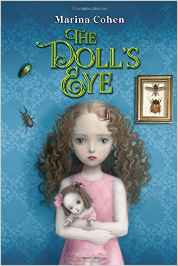| ________________
CM . . .
. Volume XXIII Number . . . .February 17, 2017
excerpt:
Hadley, 12, has been forced to leave her city apartment and move into an old house on Orchard Drive with her mother, her mother’s new boyfriend Ed, and his six-year-old son, Isaac. While the other three love their home and enjoy spending time together, Hadley sulks inside, longing for her old life in the quirky apartment in the city and her best friend, Sydney. Hadley’s mother has embraced Isaac as her new son, but Hadley resents his intrusion into their life and the loss of private time with her mother. Although her strange bug-loving new friend Gabe keeps Hadley company, he could never replace Sydney or Grace, their kooky apartment neighbour. One day, seeking a better vantage point from which to spy on the others playing in the backyard without her, Hadley ventures into the attic of the old house and discovers a glass eye and a dollhouse replica of the old Orchard Drive home. When Hadley can’t stop thinking of the unique dollhouse, she brings the house and family of three dolls into her bedroom along with a glass doll’s eye she pocketed in the attic. Once the dollhouse is in Hadley’s room, life starts to take a macabre turn and spiral out of control. Althea de Mone, the kindly old “Granny” who lives above the garage, befriends Hadley, but she is definitely not who she seems; Hadley’s limbs start to numb then disappear and reappear in thin air; and the dollhouse and its inhabitants seem to take on lives of their own. Frustrated with her new family reality, Hadley wishes on her dolls that Ed and Isaac had never come into her life. When Hadley wakes up to a reality in which Ed and Isaac are no longer part of her life and she is now living with the creepy control freak father she never knew, she deeply regrets the wish and its chilling results. In a first person narrative running parallel to Hadley’s story, and set in a dual timeline in the mid to late 19th century, another little girl is living in the house on Orchard Drive with her papa, her ailing mother and their German caregiver, Frau Heinzelmann. Displaced from her beloved Boston, this little girl finds solace playing with the doll that bears her likeness and with her lovely dollhouse, a replica of the Orchard Drive home. She spends her days listening to Frau Heinzelmann’s German folk tales of spirits and kobolds. Frau Heinzelmann describes how kobolds, house spirits, like to stay hidden, “but if you catch one, it might do as you please. Perhaps tidy your room for you. Or polish your shoes. Or grant you a wish.” Fascinated with the idea of a kobold in her house, the girl spreads syrup in front of her dollhouse and catches the kobold. Unfortunately, things don’t go as planned when the kobold grants the girl’s selfish wishes. While the granting of the wish allows her to return to Boston, her mother does emerge from her sick bed and her father does return home from working away, none of these events occur in the way the girl had envisioned. And all are granted at a horrific price, the price of one of the girl’s eyes. The Doll's Eye, a suspenseful read for fans of horror, will delight young readers looking for a scare. Marina Cohen masters the dual timeline and weaves the two stories together through character and setting. The descriptions of the kobold, the creepy Granny and the seemingly haunted house on Orchard Drive could leave some young readers awake at night, and The Doll's Eye is not for the faint of heart. While this reader became engrossed in the fast pace and suspense, eager to see how both stories would ultimately conclude, Cohen’s ending came as an eerie surprise. There is definitely the obligatory “be careful what you wish for“ directive, but all is not resolved with a happy ending here. The final disturbing chapter will leave readers clamouring for a sequel. Recommended. Cate Carlyle is a librarian at Mount Saint Vincent University in Halifax, NS.
To comment
on this title or this review, send mail to cm@umanitoba.ca.
Copyright © the Manitoba Library Association. Reproduction for personal
use is permitted only if this copyright notice is maintained. Any
other reproduction is prohibited without permission.
Next Review | Table of Contents For This Issue - February 17, 2017 |
